How to Live Deliciously With Goat Cheeses
Whether your experience with goat cheeses is limited to the common log-shaped kind, or you’re a seasoned goat cheese connoisseur, we’ve got a whole list of types for you! We’ve compiled the spreadable, crumbly, stinky, and firm in order to celebrate the wonderful world of this delicious cheese.
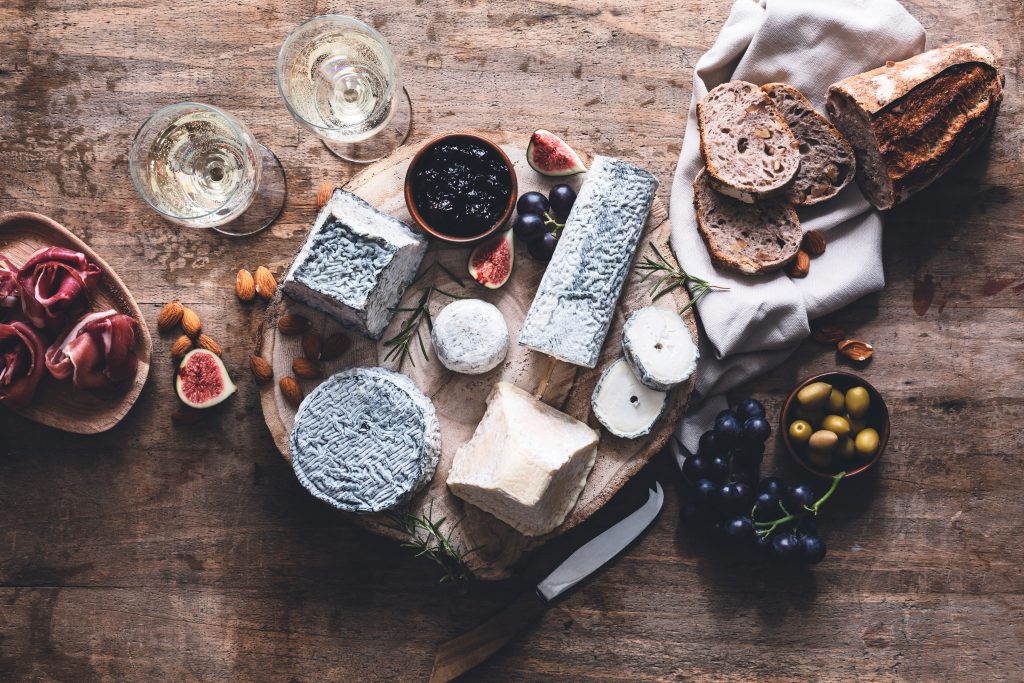
A platter of goat cheeses
Goat Cheeses: What Types Are There?
- Fresh
Rubing (Yunnan, China)
This farmer’s cheese was traditionally made with goat’s milk but the technique has evolved to include cow or yak’s milk as well. Rubing is made from adding whey to fresh milk and then it’s then put into a wooden box and pressed. Many people will cut it into slices so they can deep-fry it. Some will even put sugar on it after the frying to give it a bit of sweetness.
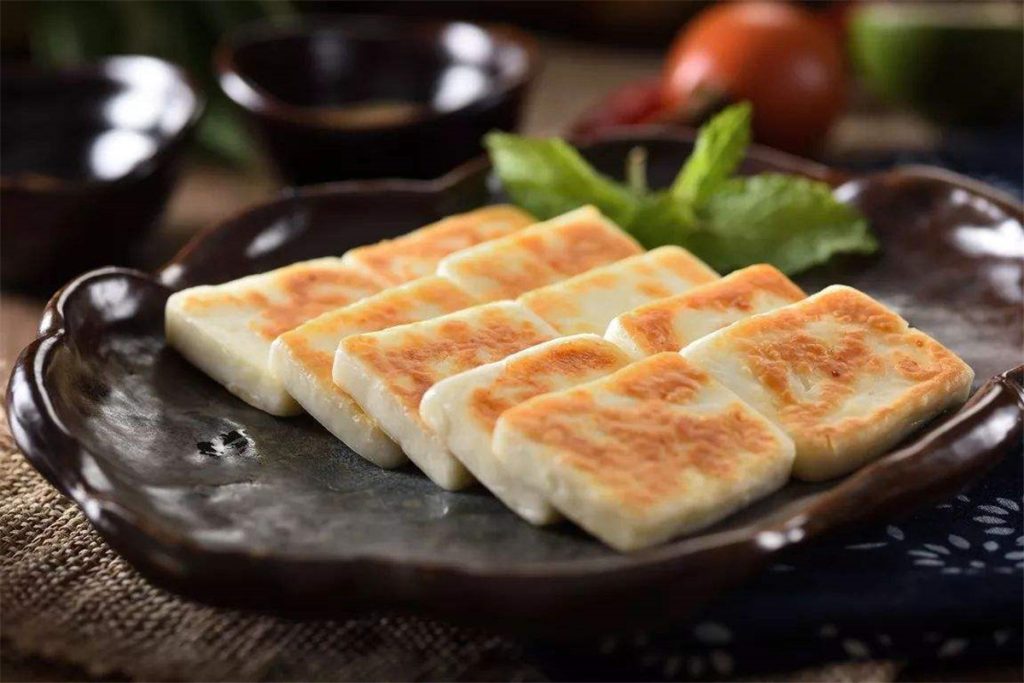
Slices of perfectly golden Rubing (Wonders of Yunnan)
Rushan (Yunnan, China)
The beginning part of the Rubing and Rushan cheesemaking process are identical, but drying them is done differently. Rushan is spread almost paper-thin onto bamboo as opposed to being pressed in the box to dry. It’s then deep-fried so it becomes crispy. Both of these cheeses are important to traditional Chinese cheesemaking.
Cornilly (Pays de la Loire, France)
Located in the Pays de la Loire region in France, Cornilly is aged for about a month. The taste is a mild, slightly nutty cheese. This soft cheese is very popular in salads. Cornilly is best paired with simple tastes, like water crackers due to its gentle taste.
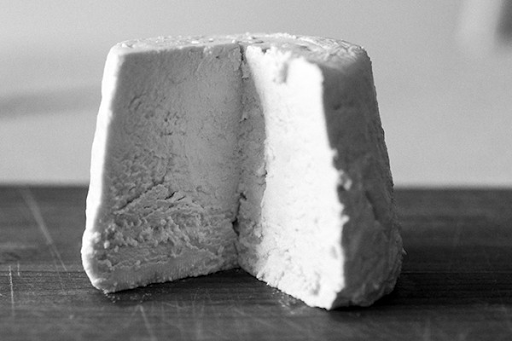
Cornilly cheese (Culture Cheese Magazine)
- Soft Ripened
Paillot de Chèvre (Québec, Canada)
You may recognize paillot de chèvre by the unique placement of plastic straws on the exterior that keep its shape and form. These sticks are based on an old tradition where cheesemakers would put a stick at the centre of cheese to keep it from collapsing or deforming. In this hazelnutty cheese, once you cut into it, you’ll see a dense cheesy centre, surrounded by a crumbly texture that’s all held together by a bloomy rind. Paillot de chèvre comes in different sizes and is an amazing little cheese.

The iconic sticks of Paillot de Chèvre
Majorero (Canary Islands, Spain)
This Spanish cheese comes in a firm and round form. It’s made of Majorero goat milk. This goat is common in the second largest Canary Island, Fuerteventura. The Guanches were the Indigenous Peoples of the Canary Islands and their word “Majorero” refers to the people of Fuerteventura. This cheese can be served rubbed with oil or pimenta, or roasted with gofio (a Canaran flour made of roasted grains).

The gorgeous burnt orange exterior of Majorero Queso (Planet Cheese)
Pélardon (Languedoc-Roussillon, France)
The cheeses of Languedoc, where the Pélardon is from, have been revered since the 1st century! Roman naturalist, Pliny the Elder, spoke about them in his work Natural History. Although he may not have been speaking about Pélardon specifically, it’s still a cheese that’s protected by the Appellation d’Origine Controlée (AOC) for its historical status. Like many goat cheeses, Pélardon has a nutty taste, but is made of raw goat’s milk and has a bloomy rind of yellow or sometimes even blue.
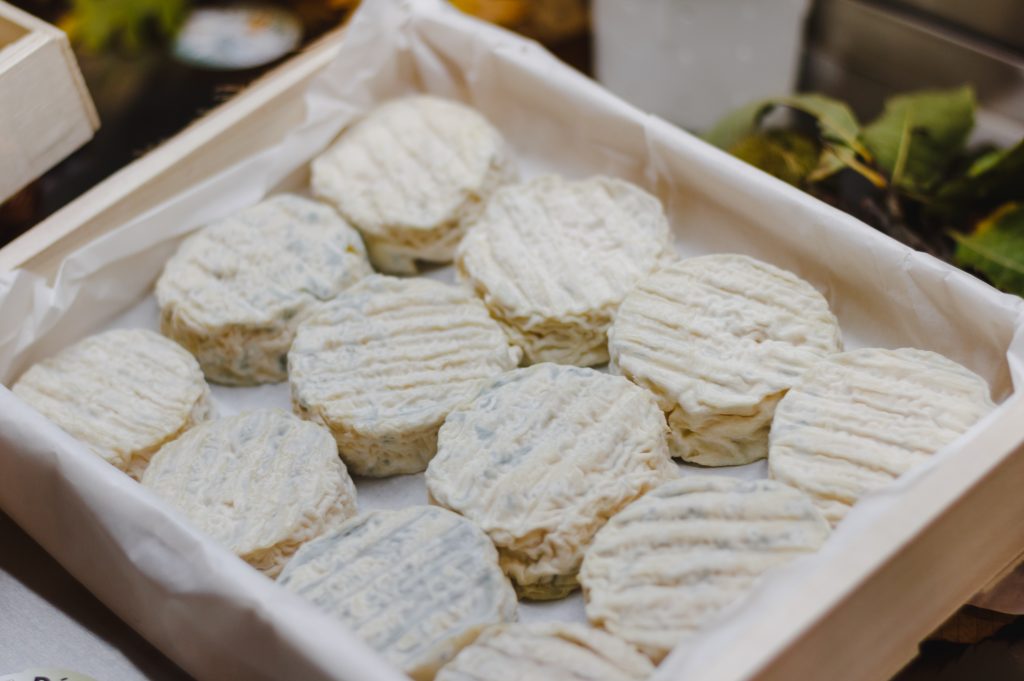
Pélardon cheeses
Picodon (Rhône, France)
The name Picodon comes from the Occitan language from Southern France, Monaco, the Occitan Valleys, and Val d’Aran. It means “spicy” or “to sting.” This cheese can be enjoyed at almost any stage of its aging process, even though it follows strict AOC guidelines such as a base of raw goat’s milk. Picodon is also nutty like many goat cheeses, but also has a bit of a sweet sourness to its flavour.
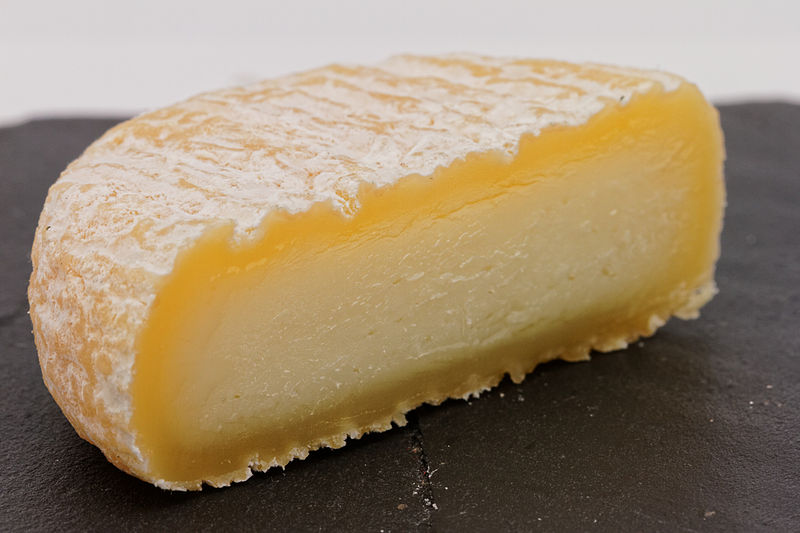
Picadon (Cheese.com)
Pouligny-Saint-Pierre (Indre, France)
As a unique goat cheese, Pouligny-Saint-Pierre (coming from the community of the same name) is shaped like a wrinkly pyramid! This cheese has been made for many years and is another example of an AOC certified cheese. It’s said to have once had the pointy top to the pyramid, and there are many theories as to where it disappeared over the years. However, what is definite is its creamy deliciousness!
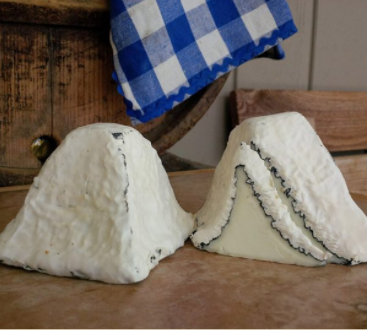
La Pyramide cheese is based on Pouligny-Saint-Pierre
Santarém (District of Santarém, Portugal)
Often preserved in olive oil, Santarém is an interesting and mysterious cheese. As its name indicates, it originates from the District of Santarém in Portugal, but is produced in more places now. You can absolutely enjoy this cheese fresh, but it’s generally advised to wait for the ripening benefits of its long olive oil soak.
Selles-sur-Cher (Centre-Val de Loire, France)
This cheese is produced in the small community that it is named after and follows the AOC guidelines, making it another historic cheese on this list. It has a lot of the classic crumbly goat cheese texture but with a grey-blue exterior. Although Selles-sur-Cher has a musty smell, it tastes quite gentle.
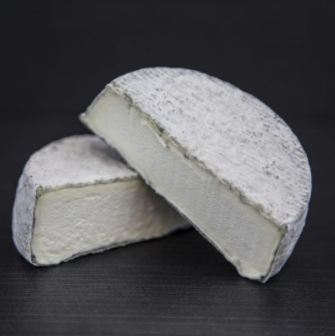
The gentle, musty deliciousness of Selles-sur-Cher
Sepet (Aegean, Turkey)
In Turkish, “sepet” means “basket” and this usage refers to the use of baskets to dry the cheese which create a woven texture on top of the final product. Many of the traditionally made cheeses in Turkey faced near extinction, but in recent years have seen an important resurgence.
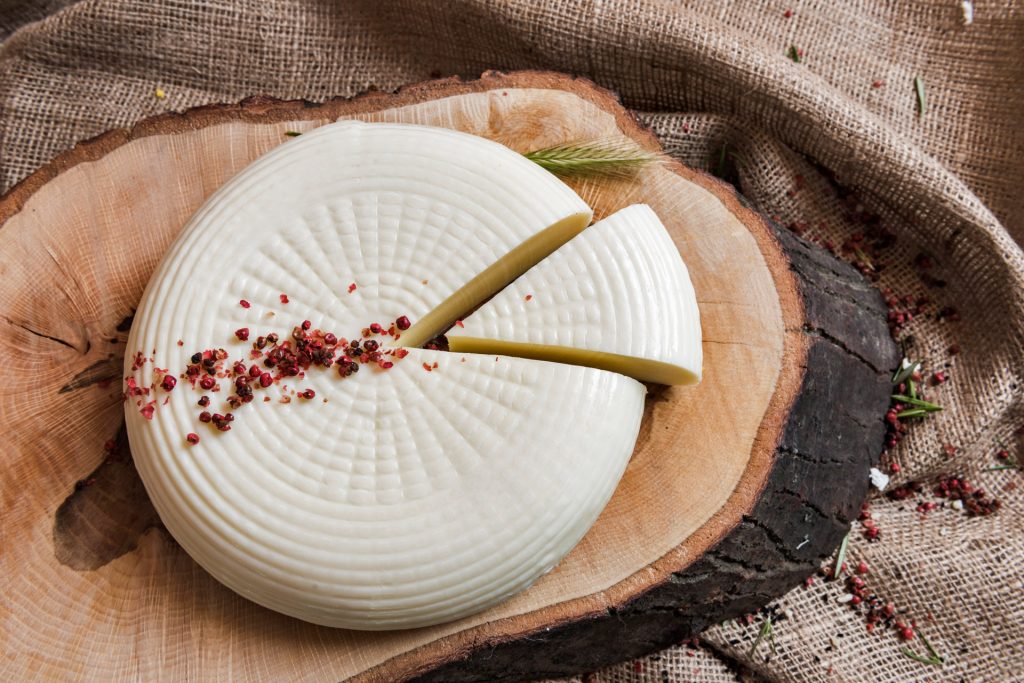
The indents from the basket are key visual factors of Sepet (Lente Cheese)
- Aged
Añejo (Mexico)
This is one of the hardest cheeses on this list; it almost has the texture of parmesan. “Añejo” means “aged” in Spanish, even though this cheese is also available fresh or young. Its sharp and salty flavours make it very good for baking or grilling and its unique vibrant red colour comes from rolling it in paprika, making it a bit spicy! You can certainly find Añejo with cow’s milk nowadays, but it was traditionally made with goat’s milk.
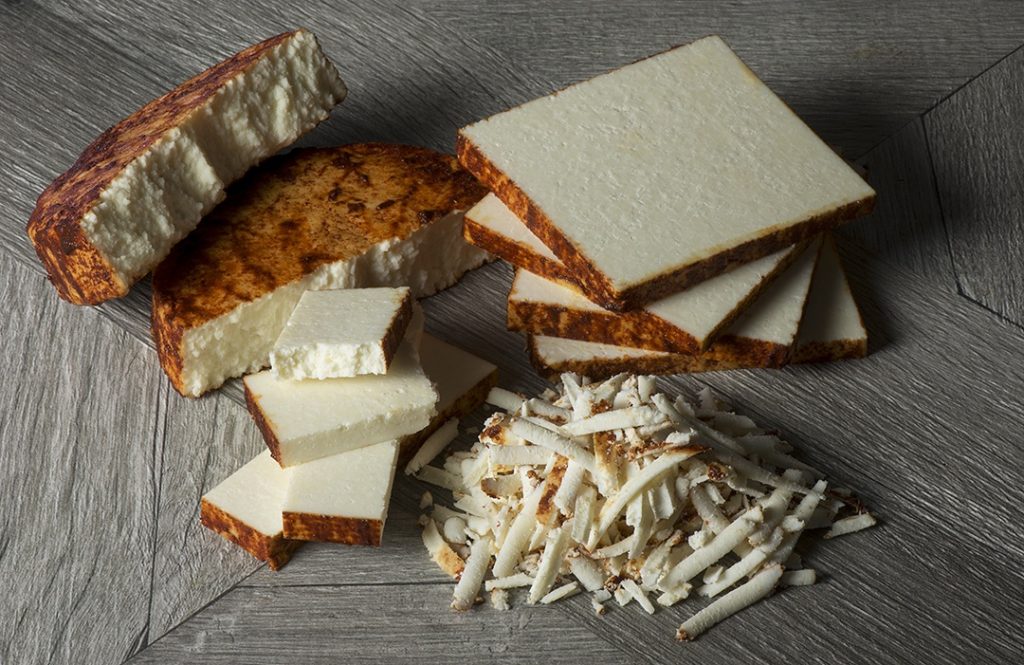
Añejo with paprika and chili powder (Cheesemakers.com)
Tulum (Turkey)
Produced in different areas of Turkey, Tulum cheese can taste a bit different depending the area it is produced in. “Tulum” disconcertingly means “skin” in Turkish, which is indicative of the way this cheese is made. Once the preparation is done, everything is put into a goatskin casing, in which it’s kept salted for several months before it’s ready to enjoy.
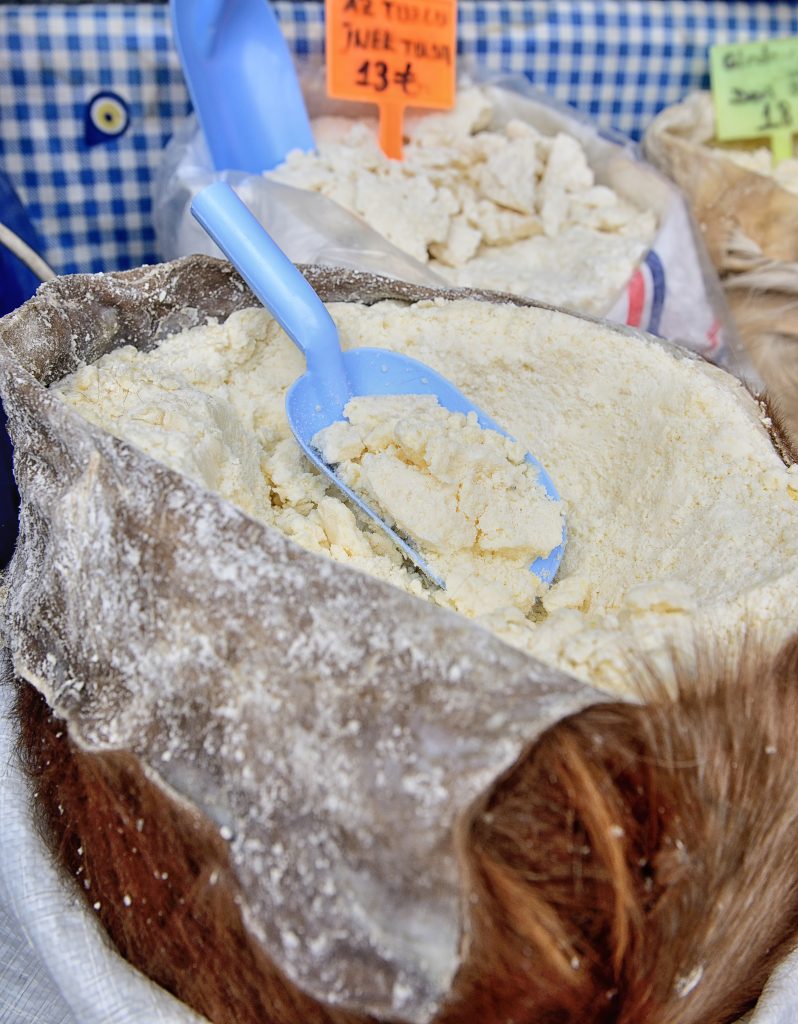
Tulum in goatskin for sale at a market
Garrotxa (Catalonia, Spain)
Pronounced, ga-ROCH-ah, this earthy and herbal cheese has a mild flavour and slightly flakey texture. Garrotxa almost went extinct in 1980, but cheesemakers made an intentional effort to bring it back the next year. It’s now left to age in literal caves in Catalonia so its mold development is just perfect.
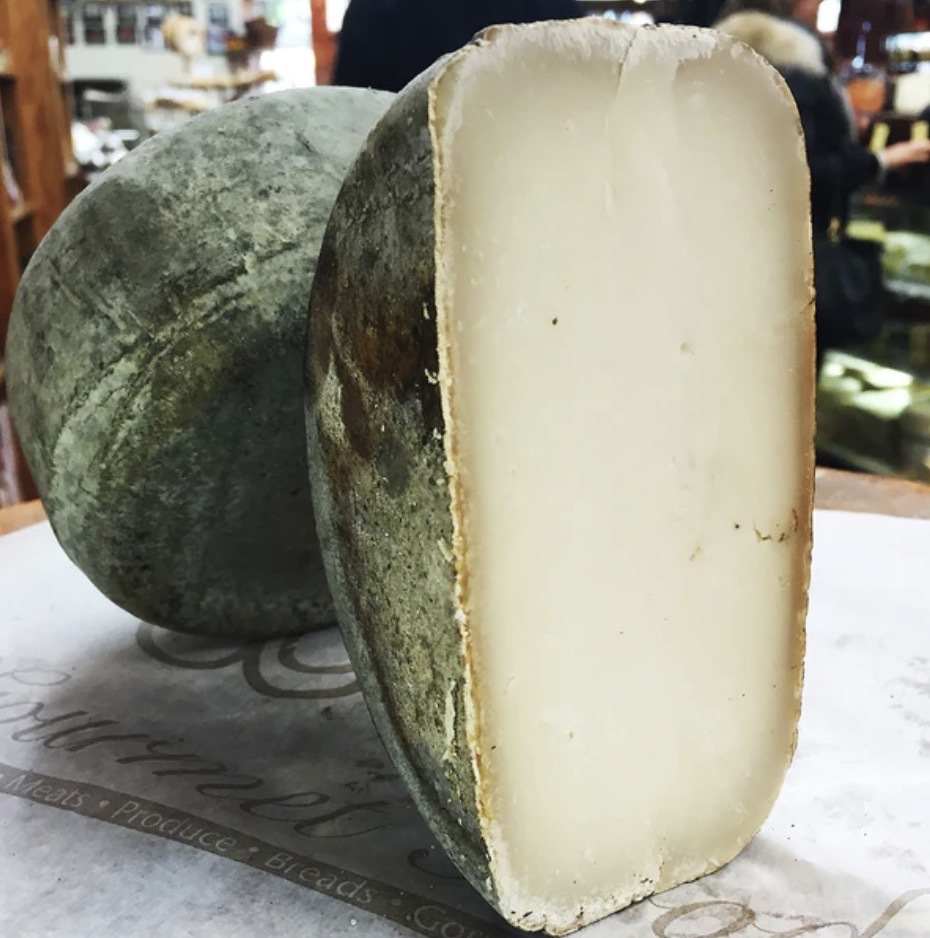
The dramatic and delicious Garrotxa
Caprino (Italy)
The Italian word for goat is “capra.” While it’s traditionally made of goat milk, it can be found produced out of cow’s milk. When fresh, Caprino is soft and spreadable, often preserved in oil. But when it’s aged, it comes in small cubes, about the size of a marshmallow. Aged Caprino t tastes a bit stronger and tangier.
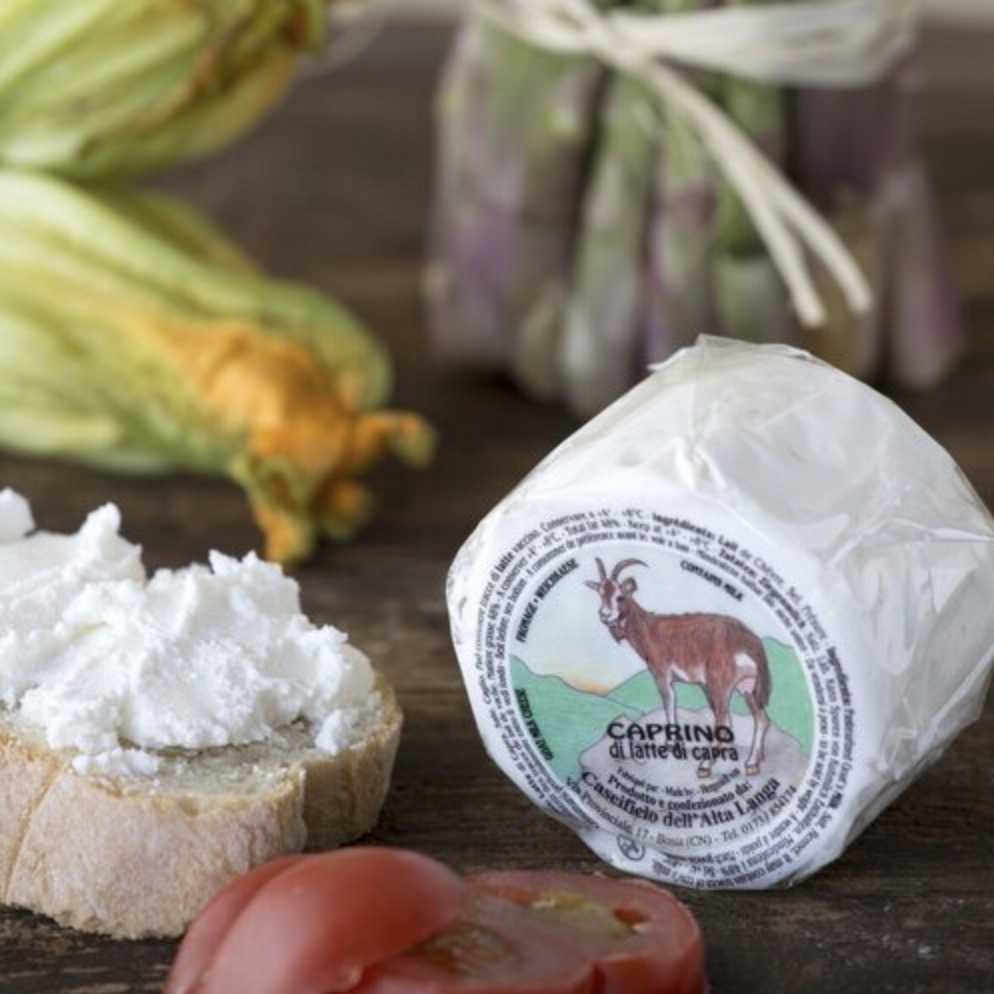
Crumbly and delicious Caprino
Kemariya or Takkmerit (Ghardaia and Naâma, Algeria)
This cheese can be enjoyed year-round, but is well-known for being a cheese of celebration. Sometimes it’s served for a special dessert with sweet accoutrements, such as honey or mint tea. And sometimes it’s kept for holidays such as Ramadan or Mawlid. The process of making Kemariya involves heating and salting it until it coagulates.
Crottin de Chavignol (Loire Valley, France)
This AOC certified cheese has been made in the 200 inhabitant community of Loire Valley since 1829. There are rumours however, that it has been made there since the 16th century! This is another type of goat cheese that can be enjoyed at various steps of its aging process. At first, it’s spreadable and soft, but over time it becomes crumbly and pungent. It never tastes sour but it shares the same nutty goat flavours that many goat cheeses share.

The AOC certified Crottin de Chavignol
Health Benefits
There is a lot of buzz in the dairy world regarding the benefits of goat versus cow products. One of the main claims is that goat cheese is a great alternative for people who have dairy allergies or intolerances. But this claim is not completely true. The main reasons why people develop aversions to dairy boil down to two main components: lactose and casein. A milk allergy usually presents itself in the first few years of life and can actually be life-threatening if not strictly adhered to. Intolerance is not necessarily life-threatening, but it can sometimes be wildly unpleasant. The claims that anyone can have goat’s milk are not to be followed by people who have allergies to milk. Thus, people with milk allergies should avoid eating any milk-based products, including ones that are made out of goat milk. But some people with intolerances are able to enjoy goat products in moderation.
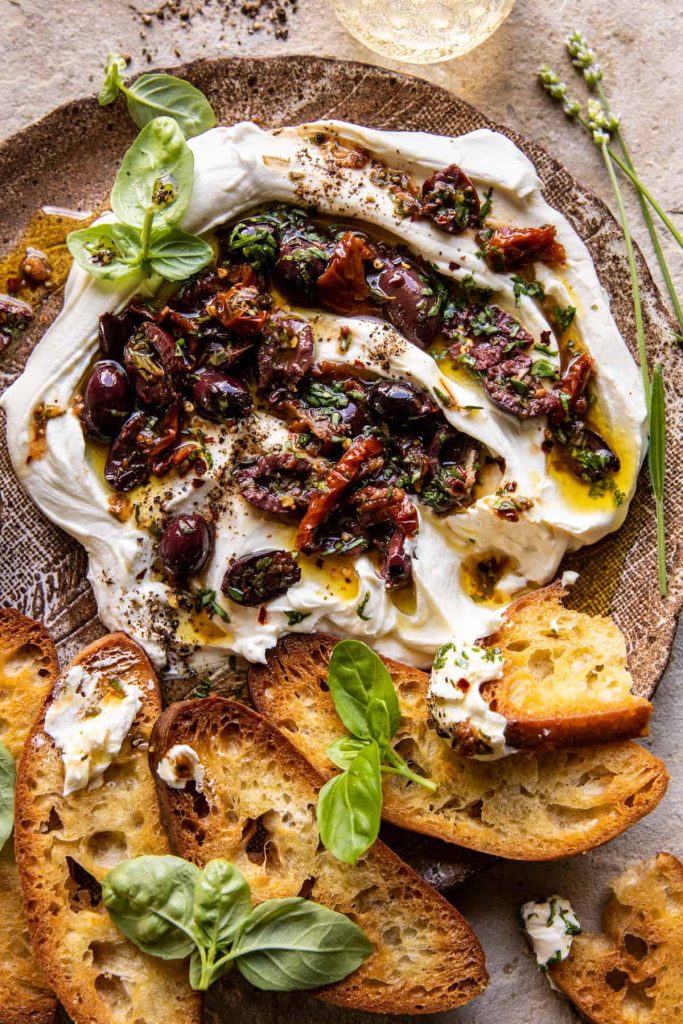
Honey Whipped Goat Cheese With Marinated Olives (Half-Baked Harvest)
The reason for this distinction between goat and cow dairy lies in the lactose and casein. Lactose is the main carbohydrate in mammal milk, and casein makes up 80% of the proteins in cow’s milk. To digest lactose, the digestive system requires an enzyme called lactase. Most mammals stop producing this enzyme once they’ve grown past the point of drinking their mothers’ milk. This is why so many people develop lactose intolerances as adults; they can’t break down this carb. A casein intolerance, or a protein intolerance, on the other hand is the body’s inflammatory response when it attempts to break down casein.
While goat’s milk still has lactose and casein in it, the lactose content is lower and the molecules are smaller and therefore, in some cases, they’re easier to digest. So it isn’t entirely inaccurate to claim that some people with milk intolerance can experience goat’s milk free of symptoms. But it is a bit misleading, as not everyone can. Other claims regarding the health benefits of goat’s milk include the healthy fat content and gut health. Although goat’s milk is higher in fat than cow’s milk, its fats break down faster and are easier to metabolize and digest than cow’s milk. In addition to that, Goat’s milk probiotic content helps with the bacteria balance in your digestive system and aids with your immune system. Now that we’ve covered some of the health benefits and myths, let’s look at the goats themselves.
Animal Welfare
Goats were domesticated about ten thousand years ago and as such, are one of the oldest domesticated animals. Because of their size, they were easy to move with and manipulate so they were especially appealing to keep for dairy. The wide use of milk in many ancient diets meant that this reliance and societal importance is one of the reasons goats represent so much in religious and folk imagery. Sacrificing one was significant because of their incredible value. And as such a valuable pagan sacrifice, when Christianity began, the goat gained symbolism as a negative force, one that even represented Satan. But there are still many countries to this day that use goat milk and cheese as their primary dairy because of their historical significance and the ease of doing so.

Marinated Goat Cheese (Serious Eats)
These same reasons for the ancient appreciation of goats are the driving force behind the modern-day resurgence of wanting a goat on a homestead. That appreciation, respect, and love for these animals is seen in larger and even industrial goat farms. But there are of course examples of farms that value profit and efficiency over the welfare of their animals. These practices are almost always legal (or at least defensible in court) because of the system of “generally accepted practices.”
Some examples of potential goat mistreatment on these farms include:
- On goat dairy farms, because of the requirement that goats give birth to produce milk, buck kids (male baby goats) can be mistreated or even killed because they are not deemed as useful for milking.
- In an effort to conserve space, some goats will never leave their stall or go outside for their entire lives.
- The act of disbudding, where the horns of a goat are removed, is a common practice in goat farming. This is done in an effort to protect the humans on the farm, the other animals, as well as the goat itself (from getting stuck in fences for instance). However depending how the procedure is done, it can result in pain for the animal, infection, and even death.
Animal Welfare and The Environment
When talking about animal farming, there is always a close link between the welfare of animals and environmental impact. If a farm is outputting the unnaturally high amount of dairy and meat that the current societal demand requires, there frequently are compromises made to the welfare of the animals. And this unnaturally high level is where we see the environmental issues arise such as greenhouse gas emissions from animal methane, water contamination or shortages, and soil degradation. So much so in fact, that many people propose that the first step to reducing agriculture’s negative impact on the environment is to increase the protection of animal welfare laws.
In the case of goat farming, there has recently been a lot of talk about how much better the animal welfare and environmental considerations are as opposed to the farming of larger ungulates (hoofed animals) such as cattle, horses, and pigs. The claims are that because they’re smaller in size, goats require less food, less space, and their methane production is not as significant as larger mammals. However, this has been disproven, stating that if goat farming was to entirely replace cow farming, the environmental impact would be on par. These findings mean that simply having smaller animals like goats is not going to be the answer to agriculture’s impact on the environment.
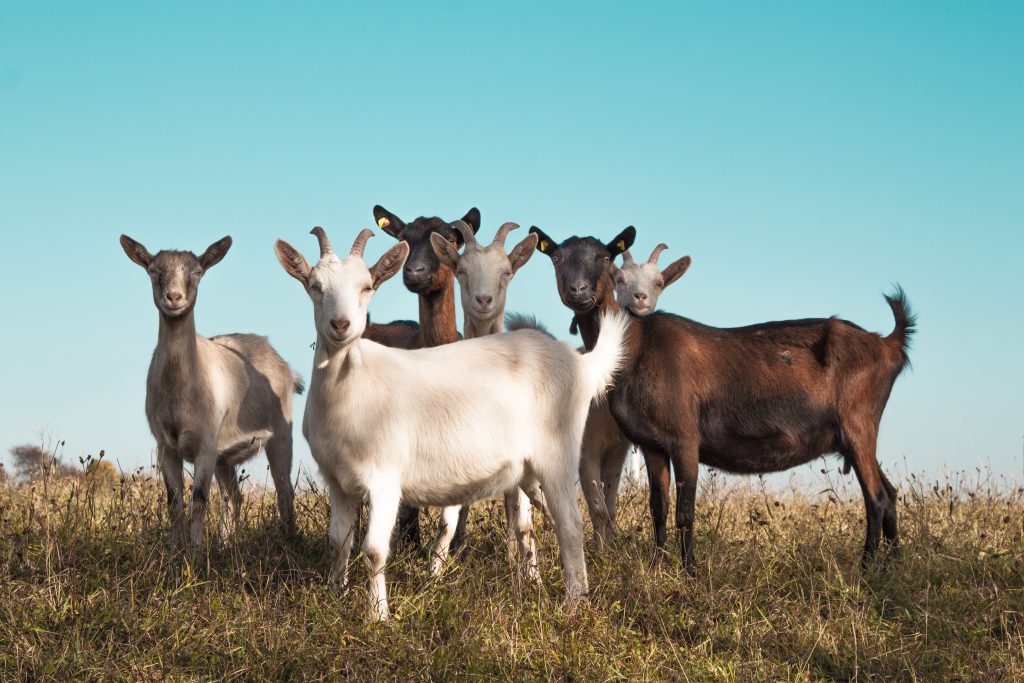
A small herd of goats
What Can be Done?
At a certain point (before the unnaturally high output we went into earlier), the more a farm fosters the welfare of an animal the more the productivity of the farm increases. This seems like the best of both worlds! Some considerations of increasing the welfare of goats specifically include the basics such as adequate space to live and roam, access to outdoor areas, and nourishing food. For the more physical safety, disbudding needs to be done with no pain, and the goats need to receive regular veterinary care, as well as hoof maintenance. There has also been an increasing demand for the mental welfare of goats. Goats in the wild have specific sizes of their herds, which are smaller than what most farms provide. And the stimulus and physical act of climbing are important for the instinct and hoof health of goats. All of these are important for improving quality of life, and can be achieved when the scale of the farm and industry are not overwhelming and when the right regulations are set in place.
So what is in our control? As a consumer, there are a variety of certifications to look out for that make it clear when a farm is following these types of welfare considerations:
- Most certifications require farms to provide transparency to consumers, give their goats adequate space to live in, food that is nourishing, and if it is a meat farm, they require the end of life process to be as humane as possible.
- If you can’t find any certified products in your local grocery store, you can always ask for them! If there is a demand, suppliers want to know.
- If there is a complete lack of the certified choice, you can always increase (or replace entirely) your consumption of plant alternative cheeses. We talk more about this in our vegan cheeses blog if you want to learn about more options.
- If you love your goat cheeses, and are lucky enough to live near farmland or have access to a farmer’s market, you can just buy local! Getting it straight from the source means you can talk to the farmers themselves and learn about their practices and ethics first hand.
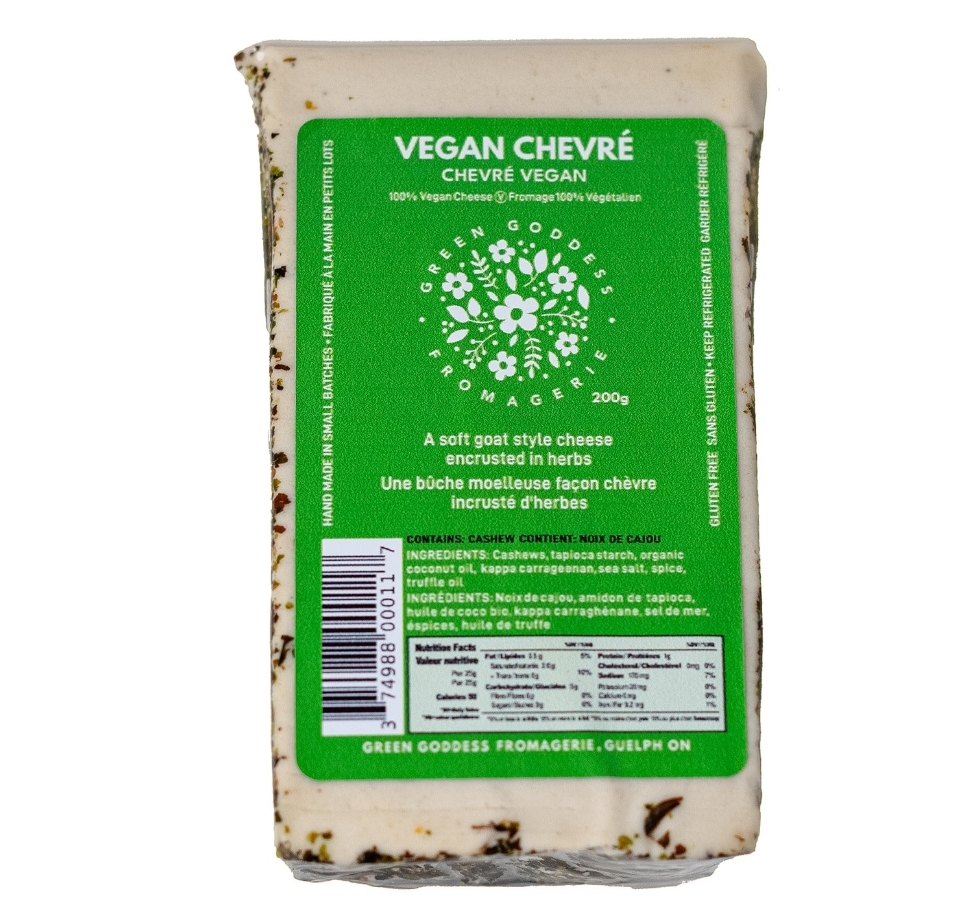
A crumbly herb encrusted Vegan Chevré
Knowing all of these factors to your favourite cheeses can change the way you look at cheese. All we can do is our best and together, we can make a difference. Whether you’re craving some of these unique goat cheeses from our list, or you’re curious what vegan cheeses are available near you, you can use our dessert-finding tool to satisfy your cravings. Enjoy!




